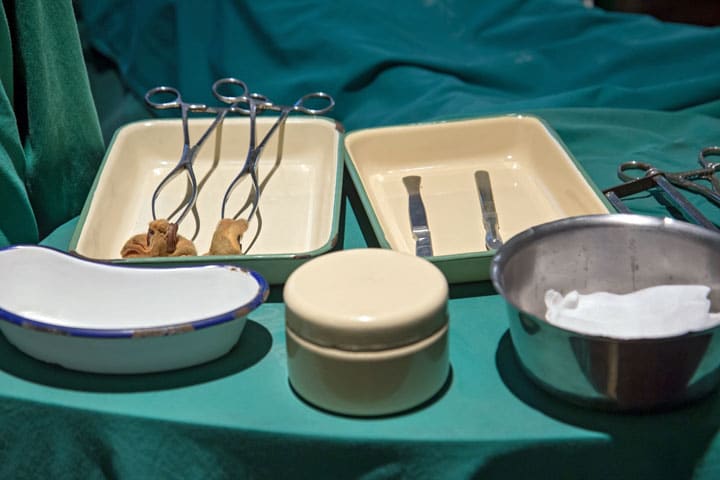Siriraj Medical Museum in Bangkok (video)
A museum boring? Well definitely not this. So if you have had enough of all the temples, shopping malls, restaurants and other entertainment venues in Bangkok, try a visit to Siriraj Medical Museum. Only for people with a strong stomach.
You will find strange and striking objects such as giant testicles, deformed fetuses, stone tools from prehistoric times, a mysterious boat, exhibitions for the blind and many more curiosities.
The Siriraj Medical Museum, nicknamed the Museum of Death, has a large collection of artifacts related to the history of medicine in Thailand. The museum contains six permanent exhibitions, plus a temporary exhibition. The six permanent exhibition sections consist of the following topics:
- Anatomy
- Congenital disorders
- Forensic pathology
- pathology
- Thai traditional medicine
- Toxicology
The museum was originally set up for medical and anatomy students, but is now open to the public. Siriraj Hospital is the oldest and largest hospital in Thailand, located in Bangkok on the west bank of the Chao Phraya River, opposite Thammasat University's Tha Phrachan campus. It is the primary teaching hospital of the Faculty of Medicine Siriraj Hospital, Mahidol University.
More information
- Address: Siriraj Medical Museum 2 Prannok road, Bangkoknoi, Bangkok.
- Opening hours: Open daily (closed on Tuesdays) from 10.00am to 17.00pm.
- Accessibility: Bus No. 19, 57, 81, 146, 149 and 157. Express Boat: Get off at Prannok Pier. Ferry service: Prachan Pier or Tha-chang Pier to Wang Long Pier.
- Website: www.si.mahidol.ac.th
Video: Siriraj Medical Museum
Watch the video below:



Very interesting. I am also glad that this is posted with address, times and transport routes. Years ago someone had indicated to take a look there. Actually forgot all those years ... Now that my daughter is studying to become a nurse, it will certainly be included in the next trip when visiting Bangkok.
Two years ago I visited this with the hospital's 125th anniversary.
I really thought it was worth it.
It is certainly not the medical world seen from a doctor's novel, but as it is and especially as it was.
A warning nonetheless.
Almost everything you get to see has ever lived, ie few plastic dolls, organs or whatever.
Keep in mind that it also includes children, which may trigger certain feelings in some people.
Therefore, people who are quite "sensitive" by nature, I advise to skip certain parts.
I went there last summer with my 15 year old son and 11 year old daughter. Interesting, fascinating but also intense. We all thought it was very worthwhile. Good to realize that certainly not all children (and adults) can handle it.
I've been there and it's nice to visit.
Didn't find it intense or shocking, especially when I see what kind of films and videos are being distributed these days. By the way, there are several museums there:
Siriraj Hospital is Thailand's first modern medical hospital and school, founded by King Rama V in 1888. The hospital complex is home to a collection of five small museums, which are:(1) Congdon Anatomical Museum (3rd fl., Anatomy Bldg.) was founded in 1927 by Prof. dr. Dr. Edgar Davidson Congdon, who was endorsed from Rockefeller Foundation to improve Thai medical studies. lt contains more than 2,000 specimens about human anatomy, including skeletons, figures of humans and animals, the bodies and organs of Siamese twins preserved in ethyl-alcohol, and, most importantly, perhaps one of the world's very few complete peripheral nervous and blood systems dissected from human bodies by Associate Professor Patai Sirikaroon.(2) Sood Sangvichien Prehistoric Museum & Laboratory (1st fl., Anatomy Bldg.) exhibits the evolution of life forms, from 500 million years ago to the beginning of primate era around 70 million years ago. The museum is named after one of Siriraj's greatest professors.(3) Songkran Niyomsane Forensic Medicine Museum (2nd fl., Adulayadejvikrom Bldg.) involves several elements in forensic science, from process of investigating the crimes by physical evidences, methods of murder, samples of skeletons and past murder cases.(4) Parasitology Museum (7th fl., Adulayadejvikrom Bldg.) exhibits various kinds of parasites such as whipworms and roundworms are exhibited, with models of their life-cycle.(5) EIlis Pathological Museum (8th fl. Adulayadejvikrom Bldg.) shows the evolution of medicine, and organs infected with different diseases
There are even 7 museums.
the Siriraj Bimuksthan Museum, Ellis Pathological Museum, Congdons Anatomical Museum, Songkran Niyomsan Forensic Medicine Museum, Parasitological Museum, Touch Museum in Honor of Queen Mother Sirikit, and Sood Sangvichien Prehistoric Museum Laboratory.
https://en.wikipedia.org/wiki/Siriraj_Medical_Museum
https://en.wikipedia.org/wiki/Siriraj_Hospital
You won't be able to see Si Quey's body there anymore.
It was removed from the museum in August 2019 and cremated at Wat Bang Phraek Tai in July 2020.
https://en.wikipedia.org/wiki/Si_Ouey